RAM CHASSIS CAB 2019 Owners Manual
Manufacturer: RAM, Model Year: 2019, Model line: CHASSIS CAB, Model: RAM CHASSIS CAB 2019Pages: 607, PDF Size: 12.68 MB
Page 231 of 607
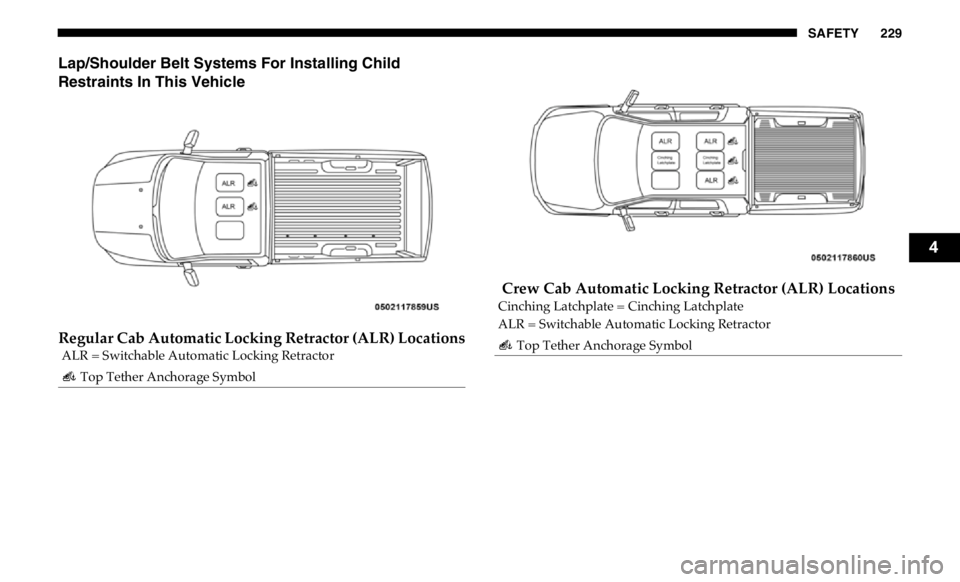
SAFETY 229
Lap/Shoulder Belt Systems For Installing Child
Restraints In This Vehicle
Regular Cab Automatic Locking Retractor (ALR) Locations Crew Cab Automatic Locking Retractor (ALR) Locations
ALR = Switchable Automatic Locking Retractor
Top Tether Anchorage Symbol Cinching Latchplate = Cinching Latchplate
ALR = Switchable Automatic Locking Retractor
Top Tether Anchorage Symbol 4
Page 232 of 607
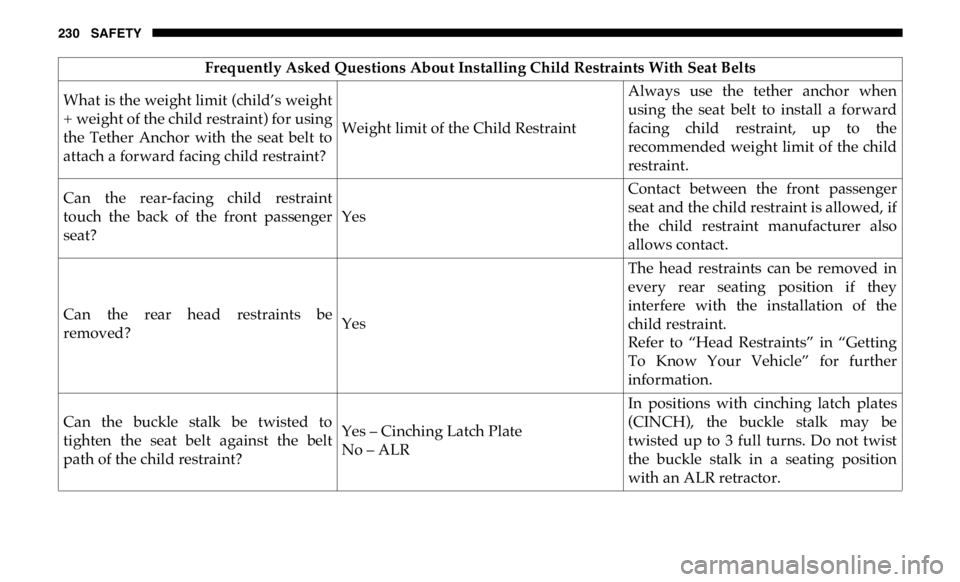
230 SAFETY
Frequently Asked Questions About Installing Child Restraints With Seat Belts
What is the weight limit (child’s weight
+ weight of the child restraint) for using
the Tether Anchor with the seat belt to
attach a forward facing child restraint? Weight limit of the Child Restraint Always use the tether anchor when
using the seat belt to install a forward
facing child restraint, up to the
recommended weight limit of the child
restraint.
Can the rear-facing child restraint
touch the back of the front passenger
seat? Yes Contact between the front passenger
seat and the child restraint is allowed, if
the child restraint manufacturer also
allows contact.
Can the rear head restraints be
removed? Yes The head restraints can be removed in
every rear seating position if they
interfere with the installation of the
child restraint.
Refer to “Head Restraints” in “Getting
To Know Your Vehicle” for further
information.
Can the buckle stalk be twisted to
tighten the seat belt against the belt
path of the child restraint? Yes – Cinching Latch Plate
No – ALR In positions with cinching latch plates
(CINCH), the buckle stalk may be
twisted up to 3 full turns. Do not twist
the buckle stalk in a seating position
with an ALR retractor.
Page 233 of 607

SAFETY 231
Installing A Child Restraint With A Switchable Automatic
Locking Retractor (ALR):
Child restraint systems are designed to be secured in vehicle
seats by lap belts or the lap belt portion of a lap/shoulder
belt.
1. For Crew Cab Models
Place the child seat in the center of the seating position.
For some second row seats, you may need to recline the
seat and/or raise the head restraint (if adjustable) to get a
better fit. If the rear seat can be moved forward and rear -
ward in the vehicle, you may wish to move it to its
rear-most position to make room for the child seat. You
may also move the front seat forward to allow more room
for the child seat. For Regular Cab Models
Place the child seat in the center of the seating position.
Move the vehicle seat as far rearward as possible to keep
the child as far from the passenger air bag as possible.
2. Pull enough of the seat belt webbing from the retractor to
pass it through the belt path of the child restraint. Do not
twist the belt webbing in the belt path.
3. Slide the latch plate into the buckle until you hear a
“click.”
4. Pull on the webbing to make the lap portion tight against
the child seat.
5. To lock the seat belt, pull down on the shoulder part of
the belt until you have pulled all the seat belt webbing out
of the retractor. Then, allow the webbing to retract back
into the retractor. As the webbing retracts, you will hear
a clicking sound. This means the seat belt is now in the
Automatic Locking mode.
6. Try to pull the webbing out of the retractor. If it is locked,
you should not be able to pull out any webbing. If the
retractor is not locked, repeat step 5.WARNING!
• Improper installation or failure to properly secure a
child restraint can lead to failure of the restraint. The
child could be badly injured or killed.
• Follow the child restraint manufacturer’s directions
exactly when installing an infant or child restraint. 4
Page 234 of 607
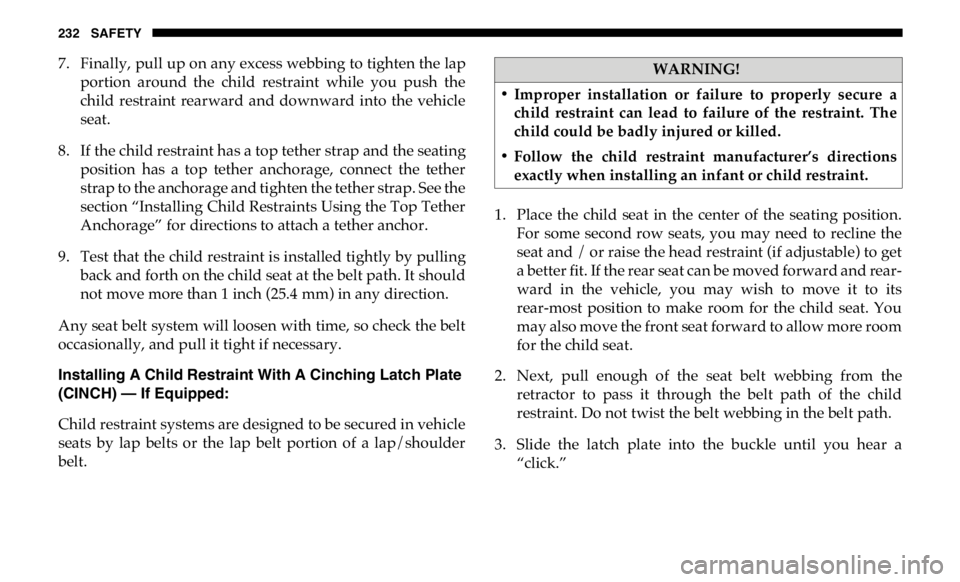
232 SAFETY
7. Finally, pull up on any excess webbing to tighten the lap
portion around the child restraint while you push the
child restraint rearward and downward into the vehicle
seat.
8. If the child restraint has a top tether strap and the seating
position has a top tether anchorage, connect the tether
strap to the anchorage and tighten the tether strap. See the
section “Installing Child Restraints Using the Top Tether
Anchorage” for directions to attach a tether anchor.
9. Test that the child restraint is installed tightly by pulling
back and forth on the child seat at the belt path. It should
not move more than 1 inch (25.4 mm) in any direction.
Any seat belt system will loosen with time, so check the belt
occasionally, and pull it tight if necessary.
Installing A Child Restraint With A Cinching Latch Plate
(CINCH) — If Equipped:
Child restraint systems are designed to be secured in vehicle
seats by lap belts or the lap belt portion of a lap/shoulder
belt. 1. Place the child seat in the center of the seating position.
For some second row seats, you may need to recline the
seat and / or raise the head restraint (if adjustable) to get
a better fit. If the rear seat can be moved forward and rear -
ward in the vehicle, you may wish to move it to its
rear-most position to make room for the child seat. You
may also move the front seat forward to allow more room
for the child seat.
2. Next, pull enough of the seat belt webbing from the
retractor to pass it through the belt path of the child
restraint. Do not twist the belt webbing in the belt path.
3. Slide the latch plate into the buckle until you hear a
“click.” WARNING!
• Improper installation or failure to properly secure a
child restraint can lead to failure of the restraint. The
child could be badly injured or killed.
• Follow the child restraint manufacturer’s directions
exactly when installing an infant or child restraint.
Page 235 of 607
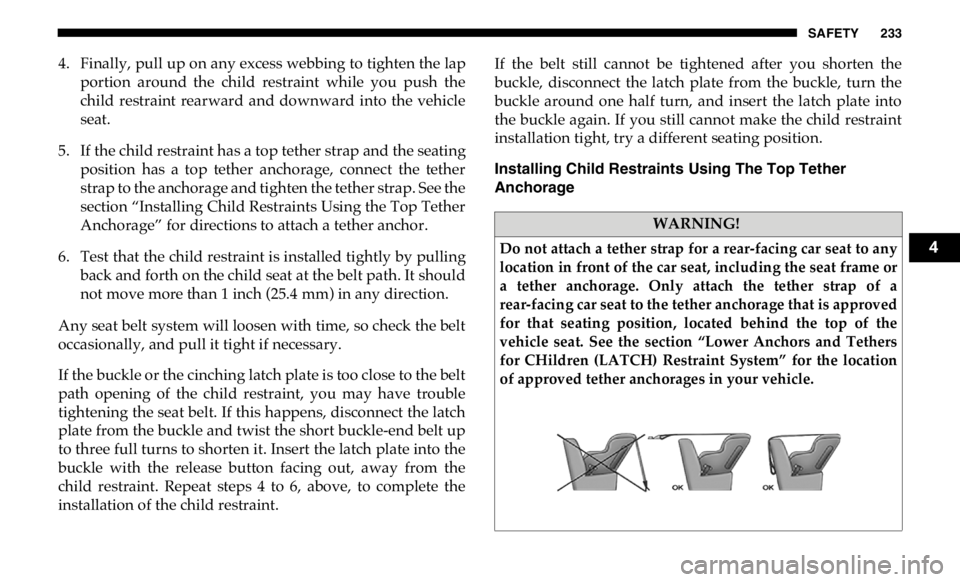
SAFETY 233
4. Finally, pull up on any excess webbing to tighten the lap
portion around the child restraint while you push the
child restraint rearward and downward into the vehicle
seat.
5. If the child restraint has a top tether strap and the seating
position has a top tether anchorage, connect the tether
strap to the anchorage and tighten the tether strap. See the
section “Installing Child Restraints Using the Top Tether
Anchorage” for directions to attach a tether anchor.
6. Test that the child restraint is installed tightly by pulling
back and forth on the child seat at the belt path. It should
not move more than 1 inch (25.4 mm) in any direction.
Any seat belt system will loosen with time, so check the belt
occasionally, and pull it tight if necessary.
If the buckle or the cinching latch plate is too close to the belt
path opening of the child restraint, you may have trouble
tightening the seat belt. If this happens, disconnect the latch
plate from the buckle and twist the short buckle-end belt up
to three full turns to shorten it. Insert the latch plate into the
buckle with the release button facing out, away from the
child restraint. Repeat steps 4 to 6, above, to complete the
installation of the child restraint. If the belt still cannot be tightened after you shorten the
buckle, disconnect the latch plate from the buckle, turn the
buckle around one half turn, and insert the latch plate into
the buckle again. If you still cannot make the child restraint
installation tight, try a different seating position.
Installing Child Restraints Using The Top Tether
Anchorage
WARNING!
Do not attach a tether strap for a rear-facing car seat to any
location in front of the car seat, including the seat frame or
a tether anchorage. Only attach the tether strap of a
rear-facing car seat to the tether anchorage that is approved
for that seating position, located behind the top of the
vehicle seat. See the section “Lower Anchors and Tethers
for CHildren (LATCH) Restraint System” for the location
of approved tether anchorages in your vehicle.
4
Page 236 of 607
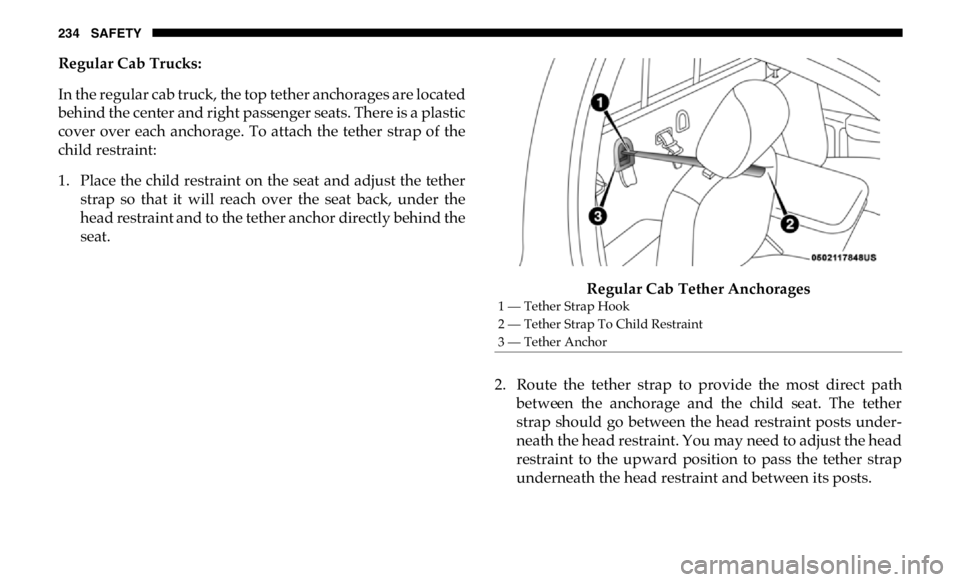
234 SAFETY
Regular Cab Trucks:
In the regular cab truck, the top tether anchorages are located
behind the center and right passenger seats. There is a plastic
cover over each anchorage. To attach the tether strap of the
child restraint:
1. Place the child restraint on the seat and adjust the tether
strap so that it will reach over the seat back, under the
head restraint and to the tether anchor directly behind the
seat.
Regular Cab Tether Anchorages
2. Route the tether strap to provide the most direct path
between the anchorage and the child seat. The tether
strap should go between the head restraint posts under -
neath the head restraint. You may need to adjust the head
restraint to the upward position to pass the tether strap
underneath the head restraint and between its posts. 1 — Tether Strap Hook
2 — Tether Strap To Child Restraint
3 — Tether Anchor
Page 237 of 607
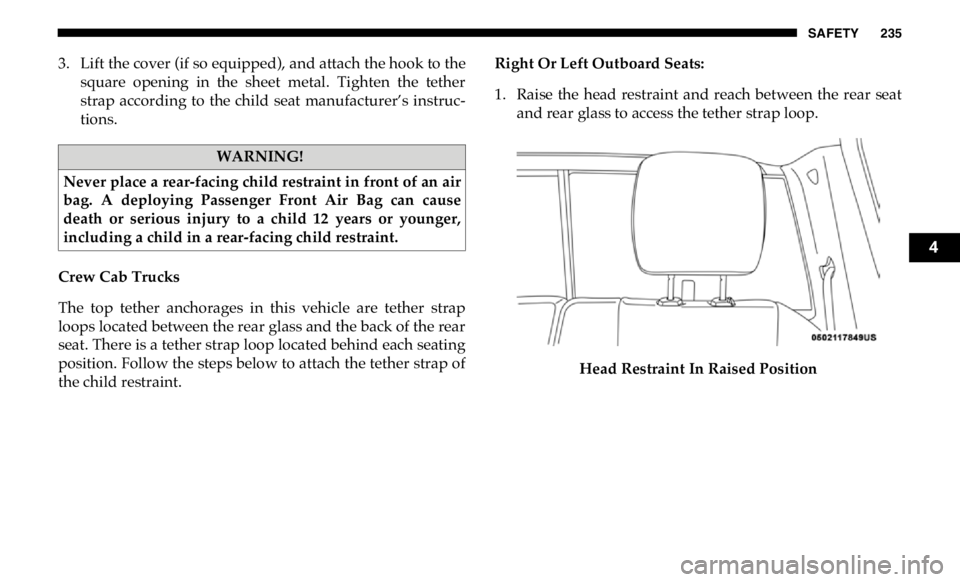
SAFETY 235
3. Lift the cover (if so equipped), and attach the hook to the
square opening in the sheet metal. Tighten the tether
strap according to the child seat manufacturer’s instruc -
tions.
Crew Cab Trucks
The top tether anchorages in this vehicle are tether strap
loops located between the rear glass and the back of the rear
seat. There is a tether strap loop located behind each seating
position. Follow the steps below to attach the tether strap of
the child restraint. Right Or Left Outboard Seats:
1. Raise the head restraint and reach between the rear seat
and rear glass to access the tether strap loop.
Head Restraint In Raised PositionWARNING!
Never place a rear-facing child restraint in front of an air
bag. A deploying Passenger Front Air Bag can cause
death or serious injury to a child 12 years or younger,
including a child in a rear-facing child restraint.
4
Page 238 of 607
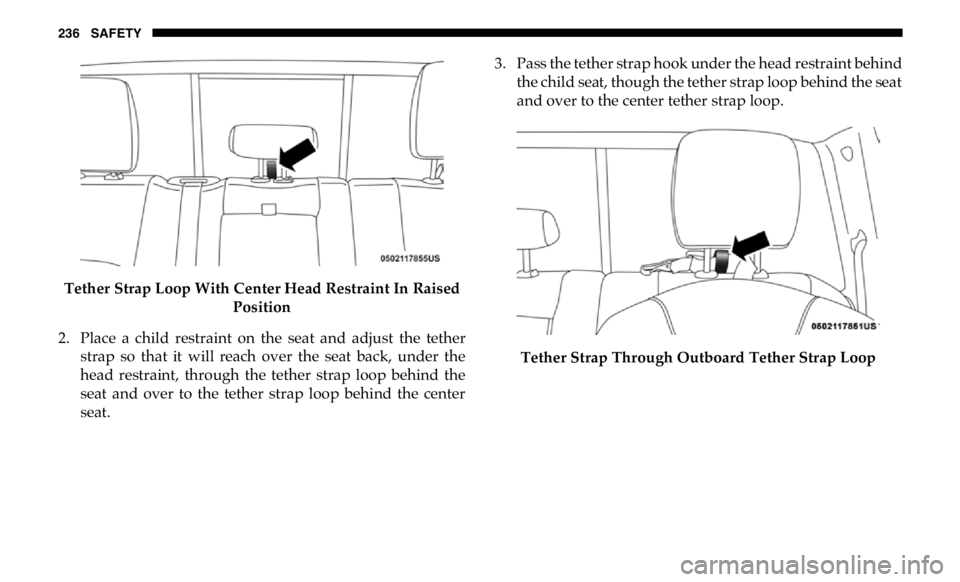
236 SAFETY
Tether Strap Loop With Center Head Restraint In Raised
Position
2. Place a child restraint on the seat and adjust the tether
strap so that it will reach over the seat back, under the
head restraint, through the tether strap loop behind the
seat and over to the tether strap loop behind the center
seat. 3. Pass the tether strap hook under the head restraint behind
the child seat, though the tether strap loop behind the seat
and over to the center tether strap loop.
Tether Strap Through Outboard Tether Strap Loop
Page 239 of 607

SAFETY 237
4. Attach the hook to the center tether strap loop (see
diagram). Tighten the tether strap according to the child
seat manufacturer’s instructions.
Tether Strap Through Outboard Tether Strap Loop And
Attached To Center Tether Strap Loop
NOTE:
If there are child seats in both of the outboard (left and right)
seating positions, the tether strap hooks of both child seats
should be connected to the center tether strap loop. This is
the correct way to tether two outboard child seats. Center Seat:
1. Raise the head restraint and reach between the rear seat
and rear glass to access the tether strap loop.
Tether Strap Loop With Head Restraint In Raised Position
2. Place a child restraint on the seat and adjust the tether
strap so that it will reach over the seat back, under the
head restraint, through the tether strap loop behind the
seat and over to the tether strap loop behind either the
right or left outboard seat. 4
Page 240 of 607

238 SAFETY
3. Pass the tether strap hook under the head restraint behind
the child seat, though the tether strap loop behind the seat
and over to the right or left outboard tether strap loop.
Tether Strap Through Center Tether Strap Loop 4. Attach the hook to the outboard tether strap loop (see
diagram). Tighten the tether strap according to the child
seat manufacturer’s instructions.
Tether Strap Through Center Tether Strap Loop And At -
tached To Outboard Tether Strap Loop